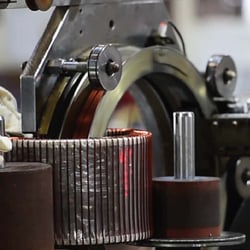It doesn’t matter if it’s a manufacturing company looking for an investment partner, or a private equity company looking for an investment in the manufacturing sector. Either way, it takes an expert in manufacturing enterprise operational excellence to identify, quantify, and prioritize operational improvement opportunities to deliver high ROI.
With nearly $800 billion in private equity “dry powder” earmarked for North America deals (according to the Wall Street Journal), and with transactions taking place at high enterprise-value-to-EBITDA ratio (EV/EBITDA) multiples, quality investment assets are in high demand. In the manufacturing sector, PwC tracked 2019 total deal value at $84.1 billion, with a volume of 2,374.
And, it’s no secret that manufacturing is an integral part of the United States economy and a key area of focus for private equity value creation. The industrial sector generates over $2.5 trillion for the U.S. economy, providing over 12 million direct jobs and nearly 6 million indirect jobs. According to the Manufacturing Institute, there are more than 255,000 manufacturers in the U.S.that produce a range of products in over 300,000 locations.
Thinking Strategically About Operations Performance
No doubt, 2019 was a pretty good year for U.S. manufacturing and most would agree that 2020 holds even more promise. However, even with a booming economy and strong federal support for nearly every industrial sector, manufacturers face complex, multi-faceted pressures. Ever-growing global competition, shifting demographics, and rapidly-evolving customer expectations combined with disruptive and evolving consumer-friendly technologies force manufacturing operations to be more agile, innovative, and responsive than ever before. These highly fluid requirements also compel companies to think more strategically about how they organize operational assets, processes, and culture to enhance the organization’s ability to align with and more effectively execute on its competitive market strategy.
Industry experts generally agree that one powerful method to achieve this is with continuous improvement in conjunction with manufacturing operations management (MOM) systems. Despite impressive case studies, when it comes to implementing MOM systems, U.S. manufacturers lag compared to other economies. For example, in a study by PwC, the USA adoption rate of sensor technology by manufacturers is 18% in comparison to Asia’s rate of 24%. Much of the organizational drag that curbs accelerated ramp-up of integrated MOM systems is organizations’ inability to achieve financial clarity in the ROI exercise.
Manufacturers that have effectively implemented and are leveraging operational technology and digital manufacturing execution system (MES) capabilities are experiencing substantial positive, quantifiable outcomes across various productivity and efficiency measures. In a study commissioned by the Manufacturing Institute, companies with MOM/MES in place have achieved significant improvements in critical manufacturing metrics including:
- Reduced labor costs by 15%-39%
- Captured 12-32% productivity gains with operational efficiencies
- Cut worker injuries 15%-25%
- Increased workforce retention 9%-26%
The ability to attract and retain a qualified workforce while also reducing overall labor costs and boosting productivity is especially important with changing demographics. Research by Deloitte estimates that from 2018 to 2028 there will be a need to fill 4.6 million manufacturing jobs in the United States. Over 2.69 million of those positions will backfill the roles of retiring workers, while nearly 2 million will be the result of industry growth. Deloitte predicts that approximately 2.4 million jobs will go unfilled because of an acute skills shortage.
Operations has Overwhelming Impact on Value

Sustainable operational improvement is essential for every organization committed to creating value and thriving in a globally competitive environment. That goal is absolutely critical for any company seeking a strategic partner or preparing for an exit strategy. Improvements in manufacturing operations — which also include supply chain, S&OP, engineering, and other disciplines — can contribute over 60% of the value creation. The value becomes amplified when consolidated and scaled through buy and build strategies. When a company effectively scales operational improvements across the organization and into the marketplace, it becomes a catalyst for sustainable value creation, generating higher levels of sales, margin, sustained EBITDA, and free cash flow (FCF) growth.
Certainly, market conditions and timing always play a role in valuation. That doesn’t diminish the need for properly configured assets, processes, and culture — a holistically aligned manufacturing enterprise — capable of executing its competitive strategy and realizing its value targets and objectives.
PE Firms Good at Investments, not Manufacturing Strategy
Private equity firms are typically armed with analysts that are experts in research, due diligence, financial modeling, investments, and negotiating. Despite the deep and varied skillsets at their command, it’s unusual for these companies to have people on staff with manufacturing operations or enterprise manufacturing performance expertise. Yet, proven operational experience and a demonstrated history of manufacturing operational excellence is required to design, implement, or guide an industrial transformation program capable of achieving the level of value expected by an investment company.
Ultimately, world-class organizations benchmark and rate maturity on a regular basis. And for the greatest ROI, it often takes an objective third-party who is an expert in manufacturing operational excellence to identify, quantify, and prioritize operational improvement opportunities. Whether your organization is a manufacturing company with operations professionals or a private equity firm, use a four-step plan to reveal value and enable the organization to capture and sustain it.
STEP 1 | ARTICULATE CORPORATE OBJECTIVES so everyone (from senior leaders to shop floor operators, including program leader) clearly understands the company’s business goals and financial metrics. This is also the time to document the technology infrastructure, supply chain strengths and challenges, plus the nuances and supporting details around sales, HR, and other supporting departments and functions.
STEP 2 | FIGURE OUT WHERE THE VALUE-ADD WILL COME FROM and where the plants are today. This might be a pre-purchase assessment, or very soon thereafter. Leadership will assign or engage an expert to:
- Benchmark each plant’s capabilities and maturity across processes, technology, and culture. It’s impossible to create an improvement plan without first understanding the current state operational capabilities and risks.
- Determine the cost, time, and effort required for each improvement activity, along with interdependencies (if any). At the same time, estimate the impact or value of each activity and the time-to-value. Some improvement opportunities are quick and relatively inexpensive to implement but yield huge returns in dollars or even workforce support for the initiative.
STEP 3 | ESTABLISH TARGETS AND GET TEAM BUY-IN. As you set priorities, establish timelines for improvement activities. This is also the time to establish how frequently the organization will benchmark capabilities maturity.
- Focus on what’s going to have the highest impact. Along the way, articulate what’s possible and how it’s relevant to ROI. As the company establishes clarity around operational improvement, it builds credibility for the initiative, and fosters enthusiasm and creativity to solve complex problems.
- Define where each plant needs to be and how it’s going to get there, in terms of culture, processes, and technology capabilities and maturity. This is the operational integration blueprint and value creation strategy roadmap.
STEP 4 | MAKE GAINS SUSTAINABLE AND AVOID BACKSLIDING by following through with regular benchmarking and evaluation. Companies that are successful with improvement initiatives arm the workforce to achieve success.
Ultimately, your manufacturing operational excellence partner should strive to help the manufacturing enterprise embrace and excel at performance improvement. The outcome is a well-aligned organization that delivers on the promise of value creation and supports higher valuation and multiples.








